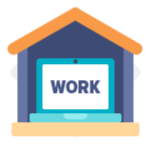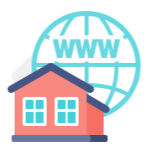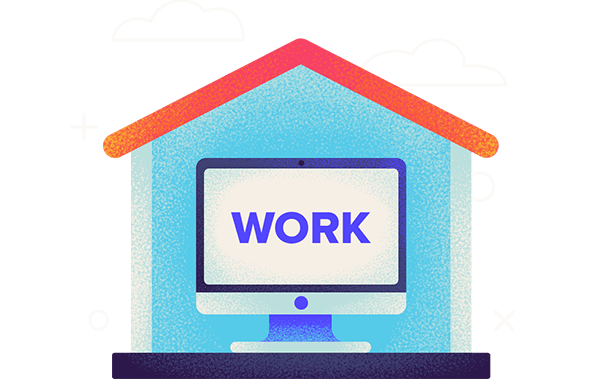Many businesses adopted a work-from-home structure during the height of the COVID-19 pandemic in order to stay afloat. While life has returned to normal now, plenty of workplaces have kept this structure in place. In fact, 13% of full-time employees now work entirely from home, while another 26% have a hybrid schedule with some time at home and some time at their employer’s building.
While more and more businesses are embracing work-from-home positions, people who are allowed to work from home may not always have the best environment for doing so. The best work-from-home conditions include low costs, reasonable comfort and a high level of security.
Exactly how easy it is to work remotely may depend on where you live. In order to find out the states that provide the best conditions for working from home, WalletHub compared the 50 states and the District of Columbia across 12 key metrics. Our data set ranges from the share of workers working from home to internet cost and cybersecurity. We also considered factors like how large and how crowded homes are in the state.

Chip Lupo, WalletHub Analyst
Main Findings
Best States for Remote Work
|
Overall Rank |
State |
Total Score |
Work Environment Rank |
Living Environment Rank |
|---|---|---|---|---|
| 1 | Delaware | 67.32 | 5 | 3 |
| 2 | Utah | 67.02 | 11 | 1 |
| 3 | Maryland | 66.51 | 3 | 5 |
| 4 | District of Columbia | 66.36 | 1 | 51 |
| 5 | New Jersey | 64.79 | 2 | 18 |
| 6 | Connecticut | 63.44 | 7 | 6 |
| 7 | Pennsylvania | 62.63 | 6 | 13 |
| 8 | Massachusetts | 62.30 | 4 | 30 |
| 9 | Washington | 61.81 | 10 | 7 |
| 10 | New Hampshire | 60.09 | 9 | 20 |
| 11 | Virginia | 59.99 | 12 | 17 |
| 12 | Rhode Island | 59.97 | 8 | 26 |
| 13 | North Carolina | 59.96 | 14 | 14 |
| 14 | Colorado | 59.80 | 29 | 2 |
| 15 | Tennessee | 58.17 | 23 | 10 |
| 16 | Florida | 57.99 | 26 | 9 |
| 17 | Georgia | 57.85 | 27 | 4 |
| 18 | Texas | 57.32 | 28 | 8 |
| 19 | Nevada | 57.15 | 22 | 16 |
| 20 | Arizona | 56.90 | 21 | 19 |
| 21 | Kentucky | 56.32 | 20 | 21 |
| 22 | Oregon | 55.41 | 25 | 28 |
| 23 | Ohio | 55.05 | 13 | 41 |
| 24 | Minnesota | 54.75 | 19 | 33 |
| 25 | Illinois | 54.56 | 17 | 37 |
| 26 | Michigan | 54.13 | 16 | 38 |
| 27 | California | 53.57 | 24 | 34 |
| 28 | South Carolina | 53.40 | 36 | 15 |
| 29 | Indiana | 53.11 | 32 | 27 |
| 30 | Nebraska | 53.03 | 39 | 12 |
| 31 | Alabama | 52.13 | 34 | 22 |
| 32 | New York | 51.79 | 15 | 48 |
| 33 | Wisconsin | 51.70 | 18 | 44 |
| 34 | Kansas | 51.40 | 38 | 23 |
| 35 | Louisiana | 51.01 | 33 | 31 |
| 36 | Vermont | 50.01 | 41 | 25 |
| 37 | Missouri | 49.18 | 37 | 35 |
| 38 | Hawaii | 49.00 | 31 | 43 |
| 39 | New Mexico | 47.95 | 42 | 32 |
| 40 | North Dakota | 47.14 | 49 | 11 |
| 41 | Idaho | 46.79 | 43 | 36 |
| 42 | Maine | 46.63 | 30 | 50 |
| 43 | Oklahoma | 46.59 | 45 | 29 |
| 44 | Iowa | 46.40 | 35 | 46 |
| 45 | Mississippi | 45.63 | 48 | 24 |
| 46 | South Dakota | 45.13 | 44 | 39 |
| 47 | West Virginia | 44.72 | 40 | 45 |
| 48 | Arkansas | 42.99 | 46 | 42 |
| 49 | Wyoming | 42.01 | 47 | 40 |
| 50 | Montana | 33.23 | 50 | 47 |
| 51 | Alaska | 30.98 | 51 | 49 |
Note: With the exception of “Total Score,” the columns in the table above depict the relative rank of each state, where a rank of 1 represents the best conditions for that category.

- Highest
- 1. District of Columbia
- 2. Colorado
- 3. Washington
- 4. Maryland
- 5. Oregon

- Lowest
- T-47. Alabama
- T-47. Arkansas
- 49. North Dakota
- 50. Louisiana
- 51. Mississippi

- Highest
- 1. Mississippi
- 2. Alabama
- 3. Louisiana
- 4. Kentucky
- 5. West Virginia

- Lowest
- 47. Alaska
- 48. North Dakota
- 49. Colorado
- 50. Montana
- 51. Vermont

- Highest
- 1. Massachusetts
- 2. Connecticut
- 3. District of Columbia
- 4. Washington
- 5. New Jersey

- Lowest
- 47. West Virginia
- 48. Montana
- 49. Oklahoma
- 50. Arkansas
- 51. Mississippi

- Highest
- 1. Kentucky
- 2. Vermont
- 3. New Hampshire
- 4. Nebraska
- 5. Wisconsin

- Lowest
- 47. Florida
- 48. New York
- 49. Alaska
- 50. Nevada
- 51. California

- Lowest
- 1. Utah
- 2. North Dakota
- 3. Idaho
- 4. Louisiana
- 5. Nebraska

- Highest
- 47. Rhode Island
- 48. Connecticut
- T-49. Massachusetts
- T-49. California
- T-49. Hawaii

- Lowest
- 1. Hawaii
- 2. New Jersey
- T-3. Delaware
- T-3. Massachusetts
- 5. Maryland

- Highest
- 46. Arkansas
- 47. Maine
- 48. Idaho
- 49. Wyoming
- 50. Montana
In-Depth Look at the Best States for Working From Home
Delaware
Delaware is the best state for working from home, with over 13% of the workforce currently doing so and nearly 97% having the potential to.
Delaware has the third-lowest internet cost in the U.S., and the 9th highest broadband-internet access. For people who do have internet, nearly 97% have access to internet speeds over 25 mbps, which should provide a smooth work-from-home experience in most cases.
The First State also has the fifth-highest average home square footages in the country, at 2,277 square feet. Homes aren’t particularly crowded, either. The median amount of square footage per person is above 918 square feet.
Utah
Utah is the second-best state for working remotely, and it has the lowest electricity prices in the country, which plays a big part in minimizing the cost of staying home all day. It also has reasonable internet costs, and the fourth-highest share of households with broadband internet.
One place where Utah stands out that many people probably don’t think about is home square footage. Utah has the biggest homes in the country, at an average of 2,800 square feet. This helps prevent people from feeling cooped up while they are working from home.
Currently, 16% of Utah’s workforce works from home, but over 95% could do their jobs from home in the future.
Maryland
Maryland is the third-best state for working from home, with some of the cheapest internet prices in the country and very high access to broadband internet. Solid internet is essential for working from home. With an average home size exceeding 2,200 square feet, Maryland State ranks seventh among the largest in the nation.
Over 17% of Maryland’s workforce currently does work from home, but over 96% of the workforce has the potential to telecommute, meaning that their jobs could be conducted remotely.
Ask the Experts
For more insight on the shift toward working at home, we turned to a panel of experts. Click on the experts' profiles below to read their bios and responses to the following key questions:
- What is the work from home outlook for 2025 and beyond?
- Should companies invest more of their resources in establishing a functional work from home alternative for their employees?
- What are the most important advantages and disadvantages of working from home?
- In evaluating the best work from home infrastructure, what are the top 3 indicators?
- Does working from home affect employee engagement?
Ask the Experts
Ph.D. – Associate Professor & Director of Graduate Studies, Department of Sociology - University of Colorado Denver
Read More
Ed.D. – Assistant Professor of Management, H. Wayne Huizenga College of Business and Entrepreneurship - Nova Southeastern University
Read More
Assistant Professor, Management and Human Resources, School of Business - University of Wisconsin – Madison
Read More
Ph.D. – Assistant Vice President- Economic & Community Development, Office of the Provost - West Virginia University
Read More
Founder & President of Eagle Backer Advisors, LLC and Executive Leadership Ph.D. Student – Clemson University School of Business
Read More
Ph.D. – Associate Professor of Management and Organizations; Affiliate Faculty - The Institute for LGBTQ+ Studies; Affiliate Faculty - Department of Gender and Women's Studies, Eller College of Management – University of Arizona
Read More
Methodology
In order to identify the best states for working from home, WalletHub compared the 50 states and the District of Columbia across two key dimensions, “Work Environment” and “Living Environment.”
We evaluated those dimensions using 12 relevant metrics, which are listed below with their corresponding weights. Each metric was graded on a 100-point scale, with a score of 100 representing the best infrastructure.
We then determined each state and the District’s weighted average across all metrics to calculate its overall score and used the resulting scores to rank-order our sample.
Work Environment - Total Points: 60
- Share of Workers Working from Home: Triple Weight (~22.50 Points)
- Share of Potential Telecommuters: Double Weight (~15.00 Points)
Note: Potential telecommuters are considered to be those in occupations classified as conducive to telecommuting: executive, administrative, managerial; professional specialty; technicians and related; sales; and administrative support. - Households’ Internet Access: Double Weight (~15.00 Points)
Note: This composite metric measures both the share of households with a broadband subscription and the share of households with access to broadband speeds greater than 25 Mbps. - Cybersecurity: Full Weight (~7.50 Points)
Note: This composite metric measures the number of internet crime victims per capita, the average amount lost as a result of internet crime and the cybersecurity risk index.
Living Environment - Total Points: 40
- Average Retail Price of Electricity: Full Weight (~3.33 Points)
- Access to Wired Low-priced Internet Plan: Full Weight (~3.33 Points)
Note: This metrics refers to low-priced broadband plans and it is a composite metric that includes:- Cable
- DSL
- Fiber
- Internet Cost: Quadruple Weight (~13.33 Points)
Note: This metrics refers to the price per Mbps. - Median Square Footage per Average Number of Persons in a Household: Double Weight (~6.67 Points)
- Share of Detached Housing Units: Full Weight (~3.33 Points)
- Average Home Square Footage: Double Weight (~6.67 Points)
- Share of for Sale Homes with Lot Greater than 1,000 Square Feet: Half Weight (~1.67 Points)
- Share of for Sale Homes with Swimming Pool: Half Weight (~1.67 Points)
Sources: Data used to create this ranking were collected as of March 10, 2025 from the U.S. Census Bureau, Global Workplace Analytics, HighSpeedInternet.com, Internet Crime Complaint Center, Wakefield Research, U.S. Energy Information Administration, BroadbandNow, Allconnect, American Home Shield Corporation and Zillow.








WalletHub experts are widely quoted. Contact our media team to schedule an interview.